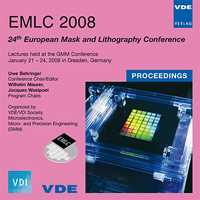MEDEA+ project 2T302 MUSCLE “Masks through user’s supply chain: leadership by excellence”
Conference: EMLC 2008 - 24th European Mask and Lithography Conference
01/21/2008 - 01/24/2008 at Dresden, Germany
Proceedings: EMLC 2008
Pages: 8Language: englishTyp: PDF
Personal VDE Members are entitled to a 10% discount on this title
Authors:
Torsy, Andreas (ALTIS Semiconductor, 224 bd John Kennedy, 91105 Corbeil Essonnes, France)
Torsy, Andreas (Infineon Technologies AG, Am Campeon 1-12, 85579 Neubiberg, Germany)
Abstract:
The rapid evolution of our information society depends on the continuous developments and innovations of semiconductor products. The cost per chip functionality keeps reducing by a factor of 2 every 18 month. However, this performance and success of the semiconductor industry critically depends on the quality of the lithographic photomasks. The need for the high quality of photomask drives lithography costs sensitively, which is a key factor in the manufacture of microelectronics devices. Therefore, the aim is to reduce production costs while overcoming challenges in terms of feature sizes, complexity and cycle times. Consequently, lithography processes must provide highest possible quality at reasonable prices. This way, the leadership in the lithographic area can be maintained and European chipmakers can stay competitive with manufacturers in the Far East and the USA. Under the umbrella of MEDEA+, a project called MUSCLE («Masks through User’s Supply Chain: Leadership by Excellence») has been started among leading semiconductor companies in Europe: ALTIS Semiconductor (Project Leader), ALCATEL Vacuum, ATMEL, CEA/LETI, Entegris, NXP Semiconductors, TOPPAN Photomasks, AMTC, Carl ZEISS SMS, DMS, Infineon Technologies, VISTEC Semiconductor, NIKON Precision, SCHOTT Lithotec, ASML, PHOTRONICS, IMEC, DCE, DNP Photomask, STMicroelectronics, XYALIS and iCADA. MUSCLE focuses particularly on mask data flow, photomask carrier, photomask defect characterization and photomask data handling. In this paper, we will discuss potential solutions like standardization and automation of the photomask data flow based on SEMI P10, the performance and the impact of the supply chain parameter within the photomask process, the standardization of photomask defect characterization and a discussion of the impact of new Reticle Enhancement Technologies (RET) such as mask process correction and finally a generic model to describe the photomasks key performance indicators for prototype photomasks.


